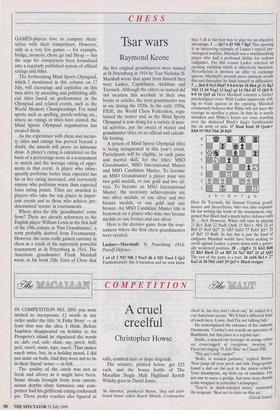CHESS
Tsar wars
Raymond Keene
GAMES-players love to compare them- selves with their competitors. However, only in a very few games — for example, bridge, memory, chess, go and Shogi — has the urge for comparison been formalised into a regularly published system of official ratings and titles.
The forthcoming Mind Sports Olympiad, which I mentioned in this column on 17 July, will encourage and capitalise on this twin drive by awarding and publishing offi- cial titles based on performance in the Olympiad and related events, such as the World Memory Championships. For mind sports such as spelling, puzzle-solving etc., where no ratings or titles have existed, the Mind Sports Olympiad organisation has created them.
As the experience with chess and memo- ry titles and ratings has proved beyond a doubt, the awards will prove an immense draw. A player's rating is calculated on the basis of a percentage score in a tournament or match and the average rating of oppo- nents in that event. A player who subse- quently performs better than expected has his or her rating increased, and conversely anyone who performs worse than expected loses rating points. Titles are awarded to players who take the top places in impor- tant events and to those who achieve pre- determined 'norms' in tournaments.
Where does the title 'grandmaster' come from? There are already references to the English player William Lewis in the first half of the 19th century as 'Past Grandmaster', a term probably derived from Freemasonry. However, the term really gained currency in chess as a result of the supremely powerful tournament at St Petersburg in 1914. The American grandmaster Frank Marshall wrote in his book Fifty Years of Chess that the five original grandmasters were named at St Petersburg in 1914 by Tsar Nicholas II. Marshall wrote that apart from himself they were Lasker, Capablanca, AleIthine and Tarrasch. Although the others so named did not mention this accolade in their own books or articles, the term grandmaster was in use during the 1920s. In the early 1950s, FIDE, the World Chess Federation, regu- larised the matter and, as the Mind Sports Olympiad is now doing for a variety of men- tal activities, put the award of master and grandmaster titles on an official and calcula- ble footing.
A system of Mind Sports Olympiad titles is being inaugurated at this year's event. Participants will be eligible, in each game and mental skill, for the titles: MSO Grandmaster, MSO International Master and MSO Candidate Master. To become an MSO Grandmaster a player must win two gold medals, or one gold and two sil- vers. To become an MSO International Master, the necessary achievements are two silver medals, or one silver and two bronze medals, or one gold and one bronze. An MSO Candidate Master title is bestowed on a player who wins two bronze medals or one bronze and one silver.
Here is the decisive game from the tour- nament where the first chess grandmasters were created.
Lasker—Marshall: St Petersburg 1914; Petroff Defence
1 e4 e5 2 Nf3 Nf6 3 Nxe5 d6 4 Nf3 Nxe4 5 Qe2 Fundamentally this is harmless and we now know
that 5 d4 is the best way to play for an objective advantage. 5 ...Qe7 6 d3 Nf6 7 Bg5 This opening is an interesting example of Lasker's typical psy- chological warfare. Marshall was a swashbuckling player who had a profound dislike for tedious endgames. For this reason Lasker selected an opening variation which is objectively harmless. Nevertheless it involves an offer to exchange queens. Marshall's seventh move unwisely avoids this and thereafter he finds himself in difficulties. 7 ...Be6 8 Nc3 Nbd7 9 0.0-0 h6 10 Bh4 g5 11 Bg3 Nh5 12 d4 Nxg3 13 hxg3 g4 14 Nh4 d5 15 Qb5 0- 0-0 16 Qa5 a6 Here Marshall commits a further psychological error. With Lasker apparently will- ing to trade queens in the opening, Marshall erroneously believes that White will not have the courage to sacrifice a piece. In that he is sorely mistaken and White's forces are soon crawling over the shattered Black's king's fortifications like an army of ants. 17 Bxa6 bxa6 18 Qxa6+ Kb8 19 Nb5 Nb6 20 Rd3
Here Dr Tarrasch, the famous German grand- master and theoretician, who was also responsi- ble for writing the book of the tournament, sug- gested that Black had a much better defence with 20 ...Nc4. However, White still wins by playing 21 Rel Rd6 22 Nxd6 Qxd6 23 Rb3+ Nb6 24 a4 Bc8 25 Re8 Qd7 26 Qb5 QxbS 27 Rxb5 Kb7 28 a5 Bd7 29 Rxf8. In fact this is just the kind of endgame Marshall would have been seeking to avoid against Lasker, a pawn down with a gener- ally weakened position. 20 ... Qg5+ 21 Kbl Bd6 22 Rb3 Rhe8 23 a4 B15 24 Na7 Bd7 25 a5 Qd2 The rest of the game is a rout. 26 axb6 Rel + 27 Ka2 c6 28 Nb5 cxh5 29 Qa7+ Black resigns


























































 Previous page
Previous page